Related Research Articles

Tripura is a state in Northeast India. The third-smallest state in the country, it covers 10,491 km2 (4,051 sq mi); and the seventh-least populous state with a population of 3.67 million. It is bordered by Assam and Mizoram to the east and by Bangladesh to the north, south and west. Tripura is divided into 8 districts and 23 sub-divisions, where Agartala is the capital and the largest city in the state. Tripura has 19 different tribal communities with a majority Bengali population. Bengali, English and Kokborok are the state's official languages.
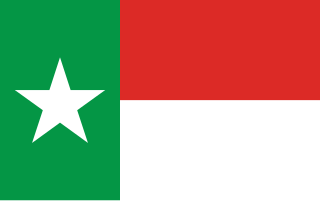
The National Liberation Front of Tripura is a banned Tripuri nationalist terrorist organisation based in Tripura, India. It has an estimated 550 to 850 members.
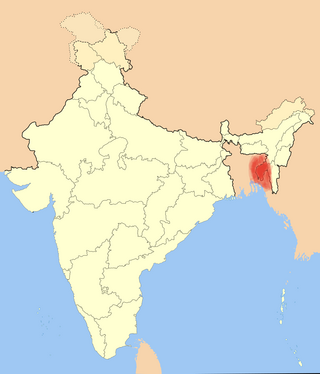
Kokborok is a Tibeto-Burman language of the Indian state of Tripura and neighbouring areas of Bangladesh.
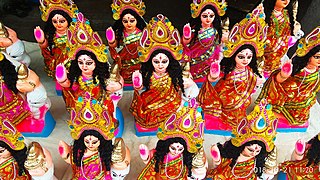
Sharad Purnima is a religious festival celebrated on the full moon day of the Hindu lunar month of Ashvin, marking the end of the monsoon season. The full moon night is celebrated in different ways in various cultural regions across Indian subcontinent.

Khonds are an indigenous Adivasi tribal community in India. Traditionally hunter-gatherers, they are divided into the hill-dwelling Khonds and plain-dwelling Khonds for census purposes, but the Khonds themselves identify by their specific clans. Khonds usually hold large tracts of fertile land, but still practice hunting, gathering, and slash-and-burn agriculture in the forests as a symbol of their connection to, and as an assertion of their ownership of the forests wherein they dwell. Khonds speak the Kui language and write it in the Odia script.
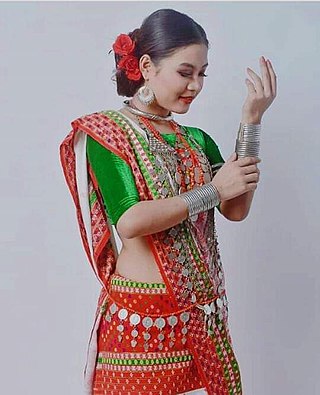
The Tripuri are a Tibeto-Burman-speaking ethnic group of Northeast Indian state of Tripura. They are the descendants of the inhabitants of the Twipra/Tripura Kingdom in North-East India and Bangladesh. The Tripuri people through the Manikya dynasty ruled the Kingdom of Tripura for ~450 years until the kingdom joined the Indian Union on 15 October 1949.
The Dances of Tripura refer to several forms of folk dance performed in the state of Tripura in northeastern India. These dances are performed by the Tripuri and Mog peoples, during annual regional celebrations, such as sowing and harvesting festivals.

The Jamatias are one of the main Tripuri clans of Tripura and the only such clan with its own customary law in practice, which is called Jamatia Raida.
Noatia are one of the Tripuri clan of Tripura state of India. The clan mainly lives in the North Tripura districts of the Tripura state of India. They speak the Noatia dialect of Kokborok which is of Tibeto-Burmese origin.
Uchoi is a Tripuri clan. They are mostly scattered in Mizoram, Tripura and Chittagong Hill Track area of Bangladesh. The “Uchoi” are considered as “Bru” In Mizoram. However, in Tripura Uchoi are considered as separate clan. In Mizoram the Uchoi are recognised as Bru and they usually considered themselves as Bru Ushoy in Mizoram. In Mizoram the Ushoy can be mostly found in the south side of Mizoram such as Lawngtlai District.
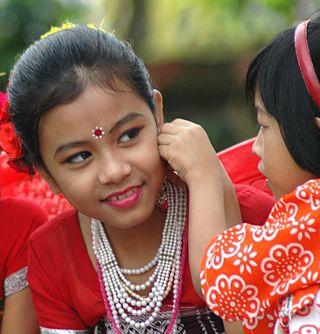
The Tripuri culture of North-East India has many distinctive features.
The indigenous people of Bangladesh are ethnic minorities in Chittagong Hill Tracts (southeastern), Sylhet Division (northeastern), Rajshahi Division (west), and Mymensingh Division (north-central) areas of the country. They are indigenous and the tribal races, total population of ethnic minorities in Bangladesh was estimated to be over 2 million in 2010. They are diverse ethnic communities including Tibeto-Burman, Austric and Dravidian people.

The culture of Tripura is distinct and a bit similar to other people of Northeast India. However like Assam, Manipur, Burma and Southeast Asia culture of Tripura is characterized in small portion where people live in plain and hill areas. Tripura is a state in North East India. In the 2001 census of India, Bengalis represented almost 70% of the population and the Tripuri population comprised 30% of Tripura's population. The Tripuri population comprises some clans and ethnic groups with diverse languages and cultures. The largest native group was the Tripuri who had a population of 543,848 in 2001 census, representing 16.99% of the state population and 54.7% of the scheduled tribe population. The other group of people in order of decreasing population were Chakma (6.5%), Halam (4.8%), Mog (3.1%), Munda, Kuki tribes and Garo Hajong. Bengali is the most spoken language, due to the dominance of Bengali people in the state. Kokborok (Tripuri/Tiprakok) is a common language among Tripuris and lingua franca in Tripura. Several other languages belonging to Indo-European and Sino-Tibetan families are spoken by the different tribe
Tripuri Kshatriya is a Vaishnav caste group which encompasses almost all the members of the Tripuri, Reang, Jamatia and Noatia ethnic groups, most of whom live in the Indian state of Tripura. The Tripuri Royal Family belonged to the Tripuri ethnic group, from the Debbarma clan. Originally the term "Tripur Kshatriya" was used to denote the Tripuri ethnic group only, but in due time, the Maharajah included the remaining three ethnic groups as well, in an attempt to foster a sense of kinship among his people. With the influx of the Bengali immigrants from neighboring places, the Tripuris lost their majority in their own kingdom and the Maharajah's power was taken away by the Indian government. Formerly, the community was organized under the Tripura Kshatriya Samaj, which was headed by the Maharajah of Tripura himself.
Here is a list of glossary of Culture of India in alphabetical order:
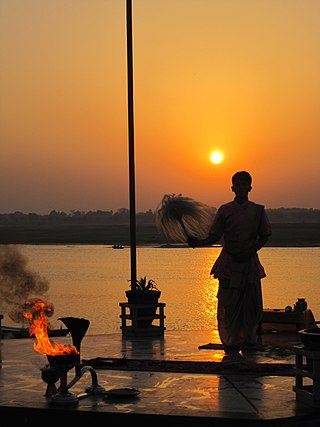
Ganga puja is a religious festival of the northeastern state of Tripura in India. The tribal Tripuri people worship the Goddess of the river, and pray to be saved from epidemic diseases and for the well-being of pregnant women. The celebration involves building a temple of bamboo in the middle of the river or a water stream. The River Ganges, known locally as Ganga, is one of the fourteen prime deities worshipped in this region. The festival is popularly celebrated throughout the state. The festival is popularly celebrated throughout the state somewhere in March, April or May, with its date fixed according to the Hindu Lunisolar calendar.
Kharchi Puja is a Hindu festival from Tripura, India. Performed in Agartala in July or August, the festival involves the worship of the fourteen gods forming the dynasty deity of the Tripuri people. Kharchi Puja is one of the most popular festivals in Tripura. It's a week-long royal Puja which falls in the month of July on the eighth day of the new moon and attracts thousands of people. This festival is celebrated at Agartala in the temple premises of Fourteen gods. There are many legends associated with this Puja. The celebrations extend until a week and are held in the temple premises which are attended by thousands of people.

The Chutia people are an ethnic group that are native to Assam and historically associated with the Chutia kingdom. However, after the kingdom was absorbed into the Ahom kingdom in 1523–24, the Chutia population was widely displaced and dispersed in other parts of Upper Assam as well as Central Assam. They constitute one of the core groups that form the Assamese people.
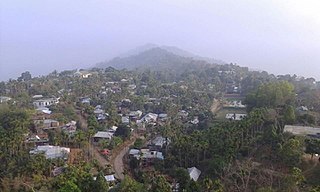
Sabual is a village in the northeastern part of Tripura state in Northeast India. It is one of the ten Mizo-Reang villages which compose the Jampui Hills range under Kanchanpur Sub-Division. The District headquarter, Dharmanagar is approximately 85 kilometers from Sabual. It sits at about 1000 meters above sea level. Summer is cool and winter season is cold. The economy of the village depend on shifting cultivation and Gardening.
Hinduism is a minority faith in Mizoram followed by 2.75% of its population. There are 30,136 Hindus in Mizoram. There are 12 temples in Mizoram and are managed by the Central Gorkha Mandir Sanchalan Samiti.
References
- ↑ "Reang Tribal Research and Cultural Institute". trci.tripura.gov.in. Retrieved 2022-12-12.
- 1 2 3 4 "A Brief Account of Riangs in Mizoram". INDIAN CULTURE. Retrieved 2022-12-12.
- ↑ Reang, Dr Lincoln. "Sustainable Development of Reang Culture in Tripura: Role of Bru Socio-Cultural Organization (BSCO)" (PDF). Conference World: 72. ISBN 9788194485506.
- ↑ of Inida, Government (1950). "THE CONSTITUTION (SCHEDULED TRIBES) ORDER, 1950" (PDF). Anagrasarkalyan. Retrieved 20 January 2024.
- ↑ "Bru people to get voting rights: Ministry". The Hindu. Retrieved 5 July 2018.
- ↑ "Bru tribals from Mizoram to permanently settle in Tripura" . Retrieved 16 January 2020.
- ↑ "Tripura, the land of fourteen gods and million statues".
- ↑ Gan-Chaudhuri, Jagadis. Tripura: The Land and its People. (Delhi: Leeladevi Publications, 1980) p. 10
- ↑ http://censusindia.gov.in/Tables_Published/SCST/dh_st_tripura.pdf [ bare URL PDF ]
- ↑ "Digital Repository of Mizoram University: Home". mzuir.inflibnet.ac.in. Retrieved 2022-12-12.
- ↑ Reang, Lincoln (2017). Mapping the Particularly Vulnerable tribal Group in Tripura. Tribal Research & Cultural Institute, Tripura. ISBN 9789386707161.
- ↑ Reang, Lincoln (2017). Mapping the Particularly Vulnerable tribal Group in Tripura. Tribal Research & Cultural Institute, Tripura. ISBN 9789386707161.
- ↑ Reang, Lincoln (2017). Mapping the Particularly Vulnerable tribal Group in Tripura. Tribal Research & Cultural Institute, Tripura. ISBN 9789386707161.
- ↑ Reang, Lincoln (2017). Mapping the Particularly Vulnerable tribal Group in Tripura. Tribal Research & Cultural Institute, Tripura. ISBN 9789386707161.
- ↑ Reang, Lincoln (2017). Mapping the Particularly Vulnerable tribal Group in Tripura. Tribal Research & Cultural Institute, Tripura. ISBN 9789386707161.
- ↑ Akhanda, Anugatamani (2008). Marriage System of the Tribal Societies of Tripura. Tribal Research & Cultural Institute, Tripura. ISBN 9789386707475.
- ↑
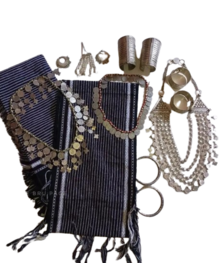
- ↑ Reang, Lincoln (2017). RELIGIOUS BELIEF AND PRACTICES OF THE REANG (BRU): TRADITION AND TRANSFORMATION. 2nd international conference on latest innovation in arts, social science and technology (PDF). Indian Federation of United Nations Associations. ISBN 9789386171771.
- ↑ "Brus become visible, but their fight for identity continues". The Hindu. Retrieved 7 March 2023.
- ↑ Deb Barma, B Motom (September 14, 2023). "Songrongma Mwtai Ter declared as Holiday". Homchang. Retrieved September 14, 2023.
- ↑ "Living in camps, thousands of Bru-Raeng children in Tripura have never heard of school".
- ↑ https://reliefweb.int/sites/reliefweb.int/files/resources/Devising%20Pathways%20for%20Appropriate%20Repatriation.pdf [ bare URL PDF ]
- ↑ http://shodhganga.inflibnet.ac.in/bitstream/10603/92967/14/14_chapter%206.pdf [ bare URL PDF ]
- ↑ http://shodhganga.inflibnet.ac.in/bitstream/10603/92967/14/14_chapter%206.pdf [ bare URL PDF ]
- ↑ "Brus claim starvation as 4 die in Tripura camps". The Hindu. 5 November 2019.

